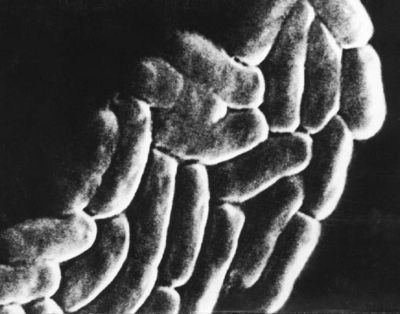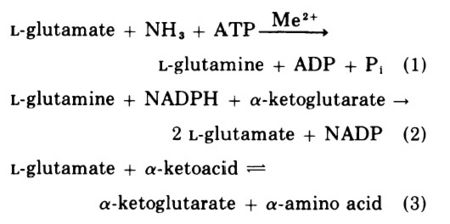Klebsiella: Difference between revisions
No edit summary |
Slonczewski (talk | contribs) |
||
| Line 29: | Line 29: | ||
==Cell Structure and Metabolism== | ==Cell Structure and Metabolism== | ||
''Klebsiella'' are non-motile, rod-shaped, | ''Klebsiella'' are non-motile, rod-shaped, proteobacteria that possess a prominent polysaccharide capsule. They are facultative aerobes, capable of both fermentation and aerobic respiration. Some of these bacteria produce an extracellular toxic complex that has been shown to be "lethal for and produce extensive lung pathology in mice" (Straus 1986). It is composed of 63% capsular polysaccharide, 30% lipopolysaccharide, and 7% protein; when introduced to experimental animals in sublethal doses, the animals built up immunization due to antibody production (Straus 1986). | ||
==Ecology== | ==Ecology== | ||
Latest revision as of 14:09, 22 February 2017
A Microbial Biorealm page on the genus Klebsiella

Classification
Higher order taxa:
Bacteria; Proteobacteria; Gammaproteobacteria; Enterobacteriales; Enterobacteriaceae
Species:
Klebsiella aerogenes; K. granulomatis; K. milletis; K. oxytoca; K. cf. planticola B43; K. pneumoniae; K. senegalensis; K. singaporensis; K. variicola; K. sp.
|
NCBI: Taxonomy Genome |
Description and Significance
Klebsiella pneumoniae is one of the most common Gram-negative bacteria seen by physicians worldwide. Pneumonias that are caused by Klebsiella pneumoniae are difficult to control; mortality rates have even been reported as up to 50% after antibiotic treatment (Straus 1986). Nitrogen metabolism in Klebsiella aerogenes has also been studied throroughly (Senior 1975).
Genome Structure
The Genome Sequencing Center at Washington U, St. Louis is presently sequencing Klebsiella pneumoniae MGH 78578. In addition, studies have been done to compare what is known of the Salmonella enterica serovars Typhimurium, Typhi, and Paratyphi A and Klebsiella pneumoniae genomes to the Escherichia coli K-12 genome. 1165 of the 4405 genes located in the E. coli genome are missing from all of the Salmonella genomes and K. pneumoniae genome. The K. pneumoniae genome was also slightly more divergent from the E. coli genome than the three Salmonella genomes (McClelland et al. 2000).
Cell Structure and Metabolism
Klebsiella are non-motile, rod-shaped, proteobacteria that possess a prominent polysaccharide capsule. They are facultative aerobes, capable of both fermentation and aerobic respiration. Some of these bacteria produce an extracellular toxic complex that has been shown to be "lethal for and produce extensive lung pathology in mice" (Straus 1986). It is composed of 63% capsular polysaccharide, 30% lipopolysaccharide, and 7% protein; when introduced to experimental animals in sublethal doses, the animals built up immunization due to antibody production (Straus 1986).
Ecology
Klebsiella are ubiquitous and may colonize the skin, pharynx, or gastrointestinal tract in humans. They form large moist colonies due to "large mucoid polysaccharide capsule (K antigen) that protects from phagocytosis and aids in adherence" (U of Maryland).
Pathology

Klebsiella pneumoniae and Klebsiella oxytoca are both opportunistic pathogens found in the environment and in mammalian mucosal surfaces; they are commonly passed by hands of hospital personel. Common sites for nosocomial Klebsiella infections inlcude the urinary tract, lower respiratory tract, biliary tract, and surgical wound sites. Clinical syndromes caused by this bacteria inlcude pneumonia, bacteremia, thrombophlebitis, urinary tract infection, cholecystitis, diarrhea, upper respiratory tract infection, wound infection, osteomyelitis, and meningitis. Infection in the lungs, called pneumonia, leads to necrosis, inflammation, and hemorrhage in the lung tissue, which produces a thick, bloody, mucoid sputum called currant jelly sputum. People at high risk to get this are middle-aged to older men with alcoholism, diabetes, or chronic bronchopulmonary disease. Two rarer infections caused by Klebsiella bacteria are rhinoscleroma, a "chronic inflammatory process involving the nasopharynx," and ozena, a "chronic atrophic rhinitis characterized by necrosis of nasal mucosa and mucopurulent nasal discharge" (Emedicine).
Nitrogen Metabolism
K. aerogenes, like other microorganisms, uses L-glutanime as the key metabolite in nitrogen metabolism. The amide nitrogen of glutamine is important in the biosynthesis of asparagine, glucosamine 6-phosphate, tryptophan, histidine, carbamyl phosphate, p-aminobenzoate, adenosine, 5'-monophosphate, cytosine 5'-triphosphate, guanosine 5'-monophosphate, glutamate, and other amino acids. The alpha-amino group of glutamine is also transferred to an alpha-keto acid in transamination reactions. All these reactions allow the biosynthesis for the assimilation of NH3 into all amino acids (Senior 1975).
In an evironment with a high concentration of ammonia and/or organic nitrogen, however, this nitrogen fixation would not be needed. In K. aerogenes, a low concentration of ammonia and/or organic nitrogen causes the repression of the glutamate dehydrogenase and the induction of glutamate synthase, an alternative supplier of glutamate within the cell; this differs from E. coli in which glutamate dehydrogenase is progressively induced during nitrogen limitation.
References
General:
- Umeh, Obiamiwe. 2002. "Klebsiella Infections." Emedicine.
- University of Maryland: KlebsiellaSummary
- Straus, David C. 1987. "Production of an extracellular toxic complex by various strains of Klebsiella pneumoniae." Infection ad Immunity, vol. 55, no. 1. American Society for Microbiology. (44-48)
Genome:
- McClelland, Michael, Liliana Florea, Ken Sanderson, Sandra W. Clifton, Julian Parkhill, Carol Churcher, Gordon Dougan, Richard K. Wilson and Webb Miller. 2000. "Comparison of the Escherichia coli K-12 genome with sampled genomes of a Klebsiella pneumoniae and three Salmonella enterica serovars, Typhimurium, Typhi and Paratyphi." Nucleic Acids Research, vol. 28, no. 24. Oxford University Press. (4974-4986)
Nitrogen Metabolism:
- Senior, Peter J. 1975. "Regulation of nitrogen metabolism in Escherichia coli and Klebsiella aerogenes: Studies with the continuous-culture technique." Journal of Bacteriology, vol. 123, no. 2. American Society for Microbiology. (407-418)

